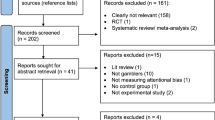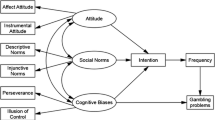Abstract
Problem gambling has been identified as a public health concern in Australia, and a considerable proportion of regular gamblers may be at risk of developing gambling related problems. Attentional bias to salient cues has been observed in substance addictions, and to some extent, in problem gamblers. This bias appears to be indicative of an increase in sensitisation to salient cues as a result of continued reforcement of a related behaviour. To test for an attentional bias to gambling-related stimuli in non-problem gamblers, the relationships between gambling frequency, gambling attitudes and beliefs (GABS-23), and attentional bias were investigated. Participants (N = 38) viewed simultaneous pairs of gambling-related and neutral images and performed a dot probe task, during which their eye-movements were recorded. This enabled both direct and indirect measures of attentional bias to be obtained. Gambling frequency and GABS-23 scores predicted both direct and indirect measures of a bias in the maintenance of attention to gambling cues. No bias in attentional engagement was found. These results suggest that regular gamblers who have not yet developed any related problems show signs of sensitisation to gambling cues and may be at risk of progressing further towards problem gambling.




Similar content being viewed by others
References
Abbott, M. W., & Clarke, D. (2007). Prospective problem gambling research: Contribution and potential. International Gambling Studies, 7(1), 123–144. doi:10.1080/14459790701261714.
American Psychiatric Association. (2013). Diagnostic and statistical manual of mental disorders (5th ed.). Arlington, VA: American Psychiatric Publishing.
Blaszczynski, A., & Nower, L. (2002). A pathways model of problem and pathological gambling. Addiction, 97, 487–499. doi:10.1046/j.1360-0443.2002.00015.x.
Bouju, G., Hardouin, J.-B., Boutin, C., Gorwood, P., Bourvellec, J.-D. L., Feuillet, F., et al. (2013). A shorter and multidimensional version of the Gambling Attitudes and Beliefs Survey (GABS-23). Journal of Gambling Studies, 1–19. doi:10.1007/s10899-012-9356-3.
Breen, R. B., & Zuckerman, M. (1999). `Chasing’ in gambling behavior: Personality and cognitive determinants. Personality and Individual Differences, 27, 1097–1111. doi:10.1016/S0191-8869(99)00052-5.
Brevers, D., Cleeremans, A., Bechara, A., Laloyaux, C., Kornreich, C., Verbanck, P., et al. (2011). Time course of attentional bias for gambling information in problem gambling. Psychology of Addictive Behaviors, 25, 675–682. doi:10.1037/a0024201.
Castellanos, E. H., Charboneau, E., Dietrich, M. S., Park, S., Bradley, B. P., Mogg, K., et al. (2009). Obese adults have visual attention bias for food cue images: evidence for altered reward system function. International Journal of Obesity, 33(9), 1063–1073. doi:10.1038/ijo.2009.138.
Clarke, P. J., Macleod, C., & Guastella, A. J. (2013). Assessing the role of spatial engagement and disengagement of attention in anxiety-linked attentional bias: A critique of current paradigms and suggestions for future research directions. Anxiety Stress Coping, 26(1), 1–19. doi:10.1080/10615806.2011.638054.
Dickerson, M., McMillen, J., Hallebone, E., Volberg, R., & Woolley, R. (1997). Definition and incidence of problem gambling, including the socio-economic distribution of problem gamblers. Melbourne: Victorian Casino and Gaming Authority. ISBN 9780731108299.
Ferris, J., & Wynne, H. (2001). The Canadian problem gambling index: Final report. Canadian Centre on Substance Abuse (submitted).
Field, M., & Cox, W. M. (2008). Attentional bias in addictive behaviors: A review of its development, causes, and consequences. Drug and Alcohol Dependence, 97(1–2), 1–20. doi:10.1016/j.drugalcdep.2008.03.030.
Field, M., Munafò, M. R., & Franken, I. H. A. (2009). A meta-analytic investigation of the relationship between attentional bias and subjective craving in substance abuse. Psychological Bulletin, 135(4), 589–607. doi:10.1037/a0015843.
Fox, E., Russo, R., Bowles, R., & Dutton, K. (2001). Do threatening stimuli draw or hold visual attention in subclinical anxiety? Journal of Experimental Psychology: General, 130, 681–700. doi:10.1037/0096-3445.130.4.681.
Hing, N., & Nisbet, S. (2010). A qualitative perspective on physical, social and cognitive accessibility to gambling. Journal of Gambling Issues 101–120. doi: 10.4309/jgi.2010.24.7.
Holtgraves, T. (2009). Evaluating the Problem Gambling Severity Index. Journal of Gambling Studies, 25(1), 105–120. doi:10.1007/s10899-008-9107-7.
Hønsi, A., Mentzoni, R. A., Molde, H., & Pallesen, S. (2013). Attentional bias in problem gambling: A systematic review. Journal of Gambling Studies, 29, 359–375. doi:10.1007/s10899-012-9315-z.
Klinger, E., & Cox, W. M. (2004). Motivation and the theory of current concern. In W. M. Cox & E. Klinger (Eds.), Handbook of motivational counseling: Concepts, approaches, and assessment (pp. 3–27). West Sussex: Wiley.
Korn, D., Gibbins, R., & Azmier, J. (2003). Framing public policy towards a public health paradigm for gambling. Journal of Gambling Studies, 19, 235–256. doi:10.1023/A:1023685416816. http://link.springer.com/article.
Lyk-Jensen, S. V. (2010). New evidence from the grey area: Danish results for at-risk gambling. Journal of Gambling Studies, 26, 455–467. doi:10.1007/s10899-009-9173-5.
Messerlian, C., & Derevensky, J. L. (2005).Youth gambling: A public health perspective. Journal of Gambling Issues, 14. doi: 10.4309/jgi.2005.14.9.
Molde, H., Pallesen, S., Sætrevik, B., Hammerborg, D. K., Laberg, J. C., & Johnsen, B.-H. (2010). Attentional biases among pathological gamblers. International Gambling Studies, 10(1), 45–59. doi:10.1080/14459791003652501.
Oh, H., & Hsu, C. H. C. (2001). Volitional degrees of gambling behaviors. Annals of Tourism Research, 28, 618–637. doi:10.1016/S0160-7383(00)00066-9.
Ozga, D., & Brown, J. (2002). Pathological gambling. Identification and treatment. Journal of Psychosocial Nursing and Mental Health Services, 40(3), 22–30.
Potenza, M. N. (2008). The neurobiology of pathological gambling and drug addiction: An overview and new findings. Philosophical Transactions of the Royal Society B: Biological Sciences, 363, 3181–3189. doi:10.1098/rstb.2008.0100.
Productivity Commission. (2010). Australia’s Gambling Industries (vol 1). Commonwealth of Australia, Canberra. doi:10.1007/s11469-013-9432-7.
Robinson, T. E., & Berridge, K. C. (2001). Incentive-sensitization and addiction. Addiction, 96(1), 103–114. doi:10.1046/j.1360-0443.2001.9611038.x.
Robinson, T. E., & Berridge, K. C. (2008). The incentive sensitization theory of addiction: Some current issues. Philosophical Transactions of the Royal Society B: Biological Sciences, 363, 3137–3146. doi:10.1098/rstb.2008.0093.
Shaffer, H., & Korn, D. (2002). Gambling and related mental disorders: A public health analysis. Annual Review of Public Health, 23, 171–212. doi:10.1146/annurev.publhealth.23.100901.140532.
Strong, D. R., Breen, R. B., & Lejuez, C. W. (2004). Using item response theory to examine gambling attitudes and beliefs. Personality and Individual Differences, 36(7), 1515–1529. doi:10.1016/j.paid.2003.06.001.
Theeuwes, J., Kramer, A. F., Hahn, S., Irwin, D. E., & Zelinsky, G. J. (1999). Influence of attentional capture on oculomotor control. Journal of Experimental Psychology: Human Perception and Performance, 25(6), 1595–1608. doi:10.1037/0096-1523.25.6.1595.
Thomas, S., Lewis, S., Duong, J., & McLeod, C. (2012a). Sports betting marketing during sporting events: A stadium and broadcast census of Australian Football League matches. Australian and New Zealand Journal of Public Health, 36, 145–152. doi:10.1111/j.1753-6405.2012.00856.x.
Thomas, S. L., Lewis, S., McLeod, C., & Haycock, J. (2012b). ‘They are working every angle’. A qualitative study of Australian adults’ attitudes towards, and interactions with, gambling industry marketing strategies. International Gambling Studies, 12, 111–127. doi:10.1080/14459795.2011.639381.
Thomas, S. L., Lewis, S., Westberg, K., & Derevensky, J. (2013). What influences the beliefs, behaviours and consumption patterns of ‘moderate risk’ gamblers? International Journal of Mental Health and Addiction, 11, 474–489. doi:10.1007/s11469-013-9432-7.
Vizcaino, E. J. V., Fernandez-Navarro, P., Blanco, C., Ponce, G., Navio, M., Moratti, S., et al. (2013). Maintenance of attention and pathological gambling. Psychology of Addictive Behaviors, 27(3), 861–867. doi:10.1037/a0032656.
Wynne, H. (2003). Introducing the Canadian Problem Gambling Index. Edmonton, AB: Wynne Resources.
Yi, S., & Kanetkar, V. (2010). Implicit measures of attitudes toward gambling: An exploratory study. Journal of Gambling Issues 140–163. doi: 10.4309/jgi.2010.24.9.
Author information
Authors and Affiliations
Corresponding author
Rights and permissions
About this article
Cite this article
Grant, L.D., Bowling, A.C. Gambling Attitudes and Beliefs Predict Attentional Bias in Non-problem Gamblers. J Gambl Stud 31, 1487–1503 (2015). https://doi.org/10.1007/s10899-014-9468-z
Published:
Issue Date:
DOI: https://doi.org/10.1007/s10899-014-9468-z




